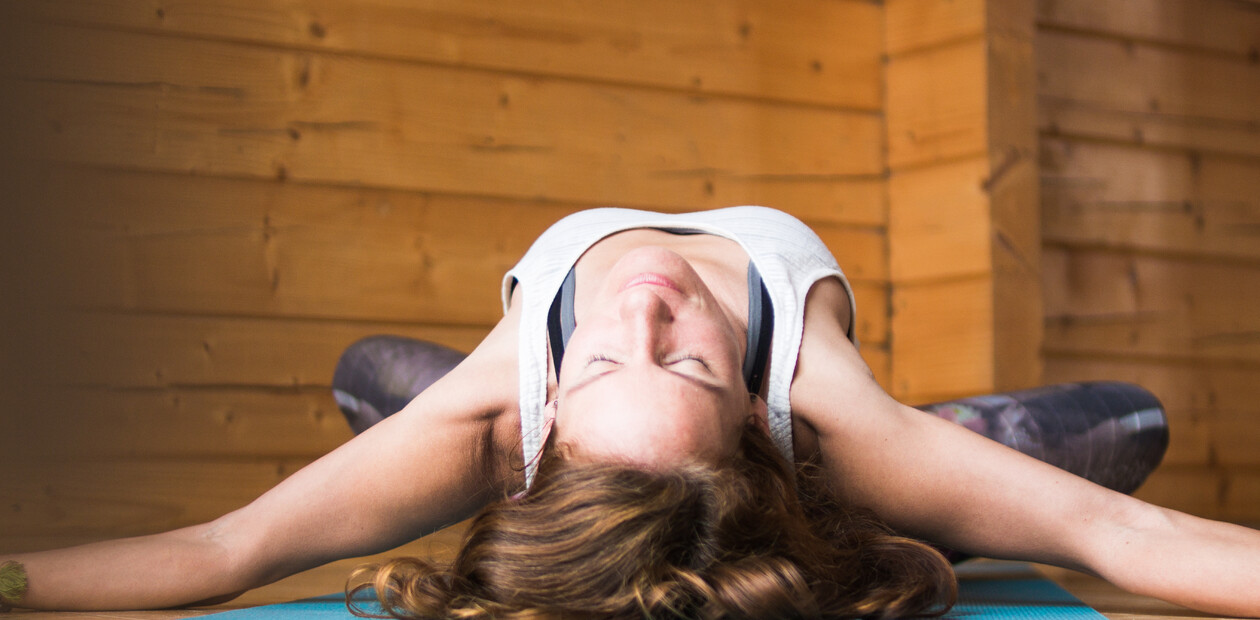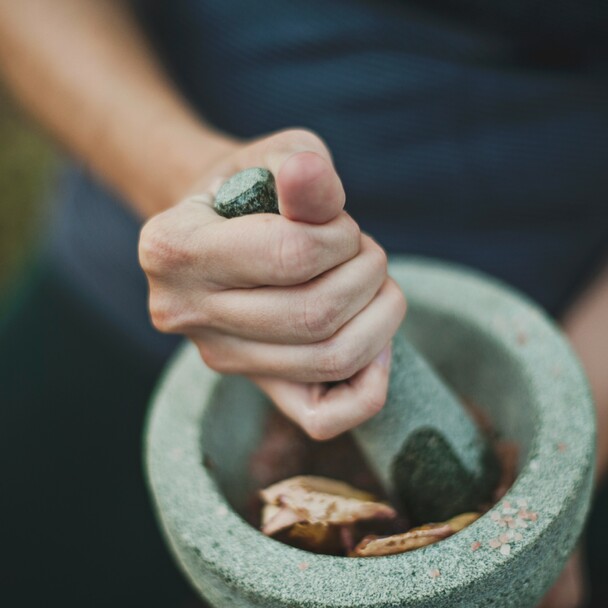Ayurveda Yoga: A holistic practice for body, mind and soul

- Brief introduction - What is Ayurveda?
- Basics of Ayurveda
- How to find out your constitution type
- Ayurveda advice during your yoga vacation
- Connection between Ayurveda and yoga
- Ayurvedic nutrition and yoga
- Recipe: Golden milk - turmeric power drink
- Book tip Ayurveda recipes
- Restful sleep with Ayurveda
- Healing with Ayurveda - What helps against headaches?
- Reduce stress with an Ayurveda massage
- What is Ayurveda yoga compared to other yoga?
- Conclusion Ayurveda Yoga

Jana is responsible for the website and blog at A-Frame. As a digital nomad and surf lover, she can work from anywhere in the world. She has currently opted for the Allgäu and El Palmar. For the Allgäu because of the love and for El Palmar because of the waves.
Brief introduction - What is Ayurveda?
Did you know that Ayurveda is 5,000 years old? Ayurveda comes from India and is the mother of all healing systems. This means that all other healing medicine originated from Ayurveda.
Translated from Indian Sanskrit, Ayurveda means "science (veda) of long life (ayur)". Ayurveda is therefore not simply a wellness trend, but a healing science that deals with the holistic. The focus and aim of Ayurveda is to activate the body's self-healing powers. This is achieved through massages, cleansing treatments (panchakarma), physical exercises (yoga), an ideal sleep rhythm and much more.
Ayurveda aims to create harmony in the body so that metabolism, digestion, tissue and excretion are balanced and diseases do not develop in the first place. With Ayurveda, health should ideally be maintained into old age.
Basics of Ayurveda
Ayurveda is an ancient healing system from India that is based on the balance of the three doshas: Vata, Pitta and Kapha. These doshas represent fundamental energies and principles in nature and in the human body. Each dosha has specific properties and functions that are important for understanding and applying Ayurveda.
The three doshas: Vata, Pitta, Kapha
Vata:
Properties: Dry, light, cold, mobile and rough.
Functions: Vata controls all movement in the body, including breathing, blood circulation, blinking and the movement of nerve impulses.
Imbalance: An imbalance of vata can lead to anxiety, dry skin, constipation and insomnia.
Pitta:
Properties: Hot, pungent, light, oily and fluid.
Functions: Pitta regulates digestion, metabolism, energy production and body temperature.
Imbalance: An imbalance of pitta can lead to inflammation, skin irritation, excessive sweating and emotional irritability.
Kapha:
Properties: Heavy, slow, cool, oily and stable.
Functions: Kapha provides structure and stability in the body, lubricates the joints, stores energy and supports the immune system.
Imbalance: An imbalance of Kapha can lead to weight gain, sluggishness, phlegm formation and depression.
Importance of dosha balance for health and well-being
The balance of the doshas is crucial for maintaining health and well-being. A balanced dosha ratio leads to a harmonious body and mind, while an imbalance can cause illness and discomfort. Ayurveda offers various methods to balance the doshas, including diet, lifestyle, yoga, meditation and herbal treatments.
Nutrition: Nutrition plays a central role in Ayurveda. Certain foods and spices can help to balance the doshas. For example, a person with a Vata imbalance should eat warm, oily and nourishing foods, while a person with a Pitta imbalance should prefer cooling and less spicy foods.
Lifestyle: Daily routines (Dinacharya) and seasonal routines (Ritucharya) are also important. Regular bedtimes, physical activity and stress management techniques can help to keep the doshas in balance.
Yoga and meditation: Certain yoga exercises and meditation techniques are designed to harmonize the doshas. For example, calming and grounding yoga poses can calm Vata, while cooling breathing exercises can balance Pitta.
Through the conscious application of these principles, Ayurveda can help you lead a holistic and balanced life. Understanding your own Dosha constitution and the measures tailored to it is the key to promoting health and well-being in Ayurveda Yoga.
How to find out your constitution type
To find out your constitution type, there are numerous tests and questionnaires in books or on the internet. However, these are only suitable for a first impression. The exact determination is very complex. For a perfect result, a pulse and tongue diagnosis is also required. A professional Ayurveda consultation is therefore the safer option. If you are our guest, A-Frame - team member Jana will be happy to help you determine your constitutional type in an Ayurveda consultation. Jana is a qualified sports manager, masseuse, yoga teacher and Ayurveda health advisor. If you would like to see for yourself at home which your dominant dosha might be, we recommend the test from the Zentrum der Gesundheit.

Ayurveda advice during your yoga vacation
In an Ayurveda consultation with Jana, you will not only find out which constitution type you are, you will also gain a basic understanding of how foods and spices can be used specifically as remedies and how imbalances can be regulated through a constitutionally appropriate lifestyle - before diseases develop. The evaluation also includes recommendations for your ideal foods, as well as tips for your morning routine, daily routine and lifestyle. Jana offers an Ayurveda yoga retreat once a year. Click here to register for the Ayurveda retreat.
Once you have found out your constitution type, you are ready to go. Now you can integrate Ayurveda perfectly into your life.
Connection between Ayurveda and yoga
Ayurveda and yoga go together perfectly. And this is neither new nor a hip trend: Ayurveda and yoga are already placed in a common context in the millennia-old Vedic texts. So both have the same origin. Our Yoga teacher and Ayurveda expert Jana describes Ayurveda and yoga as two sides of the same coin.
Holistic approach
As with yoga, Ayurveda is also about a holistic (medical) approach. Exercise, meditation and breathing exercises are just as much a part of yoga as they are of Ayurveda. Ayurveda even refers to the different practices of yoga. However, yoga also offers not only asanas but also numerous recommendations for a healthy lifestyle. The various cleansing techniques and dietary recommendations from yoga have their origins in Ayurveda. As you can see, Ayurveda and yoga complement each other perfectly.
The dream team for more energy
Ideally, you should combine both: Ayurveda and yoga. If you add the Ayurvedic principle to your yoga practice, you will achieve results even faster. This is because Ayurveda and yoga complement each other so well that your body can build up more energy and well-being. Because when you eat Ayurveda, i.e. according to your constitution, your body has more energy.
After all, the body is not busy digesting things that are not made for it. Instead, it can release energy for useful things. The same applies to a regular yoga practice. Just think how much energy and what an enormous feel-good factor you can achieve when you combine the two. Ayurveda and yoga are the dream team par excellence.

Ayurvedic nutrition and yoga
According to Ayurvedic teachings, diseases are caused by an imbalance of the three doshas. Diet is a central component of this. With the right diet, you can achieve a lot to bring your three doshas back into balance. After all, you are what you eat. Or rather, what your body metabolizes - as they say in Ayurveda. ;-)
What to look out for in an Ayurvedic diet
Ayurvedic nutrition is very extensive and can hardly be covered in one chapter. However, we have a few useful tips for you to incorporate a little Ayurveda into your everyday life:
Eat only when hungry and avoid snacks
The most important meal is lunch, as this is when the body digests best.
Drinks with meals should be warm or at room temperature. Tip: Ginger tea stimulates the organs and warms.
Depending on which dosha is dominant in your body, every Ayurvedic meal should contain the six flavors sweet, sour, salty, tart (astringent), bitter and spicy.
Start your fire! With every meal, it's important to really get your digestive fire going. Because if you don't digest food completely, so-called metabolic waste products and ama remain. These are toxic substances that can cause numerous ailments. Tip: Cardamom, lemon juice with a little ginger and salt before a meal stimulates the digestive fire Agni.
Do not combine animal proteins (fish, meat, milk, eggsI, otherwise metabolic waste products will form.
Milk should not be eaten with sour, salty or leafy vegetables, nor with fresh fruit (muesli with yoghurt and fruit is therefore not ideal).
Fruit is best eaten steamed or on its own as it otherwise leads to fermentation processes in the digestive tract.
Potatoes, pasta & fats go ideally with vegetables or salad
Rice goes with everything. :-)
Do I have to eat an Ayurvedic diet every day?
Of course, it would be ideal to eat an Ayurvedic diet every day, but the implementation is somewhat utopian. It's not about always eating 100% exactly what you tolerate best and not eating the rest at all. If you live strictly according to Ayurveda, you may soon become mentally frustrated because you can no longer go out to eat with your friends or family. Or because you are constantly denying yourself something that you actually like to eat. Ayurveda is therefore not about strictness, but rather about knowing what is good for you and what you need to do to rebalance yourself in the event of an imbalance. For example, if you are an airy Vata type, it is better to avoid dry, cold foods such as rice cakes, salads or cold drinks and instead opt for warm porridge, vegetables steamed in ghee with rice or nourishing soups. Which doesn't mean you can never eat salads or rice cakes again.
You should use Ayurveda to get a feel for what your body needs to balance itself. Add a good sesame or olive oil to a light, cold salad, heat up some of the ingredients and sprinkle on a few cashew nuts - and your salad is Vata-ready :-)
Exception: If you are currently undergoing Ayurvedic treatment to cure an illness, you should also stick to the guidelines.
Recipe: Golden milk - turmeric power drink
Here's another quick and delicious recipe from the Ayurvedic kitchen: Golden milk is also very popular among yogis. The delicious drink is also known as Golden Milk or Turmeric Latte. Golden milk not only tastes good, it also has an anti-inflammatory effect, cleanses the lungs, relieves the liver, protects against free radicals and breaks down limescale deposits. Ideal for cold days.
Recipe for two glasses of turmeric latte:
1.5 cups of milk (cow's milk, oat milk, almond milk or soy milk)
1 teaspoon of maple syrup
2 teaspoons of turmeric powder or 2 pieces of turmeric root (better!)
1 tsp cinnamon
fresh ginger
freshly ground pepper
optionally some ghee or coconut oil
Pour the milk into a pan and add all the ingredients one by one. Bring everything to the boil and then continue to simmer over a low heat until the milk has turned a dark yellow color. Now pour the milk into a container or glass. Simply leave the leftover ginger in the pan.
If you like, you can now froth up some extra milk and add it. Stir in some freshly ground pepper and ghee. Alternatively, you can also use mild oil such as coconut oil. Enjoy your meal!
By the way: Golden milk is also great for helping you fall asleep. Try this recipe:
Mix 2 pinches each of cardamom, cinnamon and turmeric and bring the spices to the boil with 1 cup of milk. Leave to cool briefly and add 1 teaspoon of honey. Sweet dreams!
Book tip Ayurveda recipes
You want more and want Ayurveda recipes? Then we recommend these two books:
The Ayurveda Cookbook: Self-Healing through Ayurvedic Cuisine by Vasant Lad & Usha Lad
The Ayurveda Kitchen by Amadea Morningstar & Urmila Desai
Restful sleep with Ayurveda
Do you often wake up exhausted in the morning? Do you have trouble sleeping through the night or falling asleep? Then maybe something is wrong with your sleep rhythm. We know this from ourselves: Sitting up late working on our laptops, then watching a Netflix series and falling asleep well after midnight. Or sleeping restlessly thanks to a late and heavy dinner. All of this takes its toll the next day when you wake up drained of energy, exhausted or irritable... But it's not that difficult to wake up fresh and rested from the land of dreams. Ayurveda has a few tips for a restful sleep:
Sleep before midnight → Ideally, you should go to bed before 10 pm
Dinner for Kapha types by 6 pm, Pitta and Vata types by 7 pm
Light evening meals such as soups
Do not look at a screen or monitor before going to bed.
Tip for Kapha types: No more than 8 hours of sleep, but like to power nap during the day.
Tip for Pitta types: 8 hours of sleep at night
Tip for restless Vata types: Sleep as much as you like and feel free to take an afternoon nap of half an hour.
Before going to bed, have a tea made from fennel seeds or warm milk with ghee, nutmeg or honey
"Healthy sleep brings happiness, nourishes the body, gives strength and vitality, gives knowledge and gives life." (From the Charaka Samhita)
Healing with Ayurveda - What helps against headaches?
Headaches are one of the most widespread ailments in Germany. The most common headaches are tension headaches and migraines. The causes vary from person to person. Ayurveda states that there are as many types of headaches as there are patients. This is because no two people are the same and therefore no two causes are the same. But no matter what the cause of your headache is, your three doshas are most likely no longer in balance. If Vata, Pitta and Kapha are imbalanced, this affects your vital energy and sense of well-being.
Headaches and migraines can therefore always be traced back to this imbalance. It is almost impossible to avoid this in life and in everyday life. The important thing now is to know how to get all three doshas back into balance and beat headaches. Here are the 10 best tips against headaches according to Ayurveda:
We've mentioned it many times before: sleep. Sleep sufficiently and regularly at the same times.
Eat warm, nutritious and easily digestible food
Try to avoid or minimize coffee, black tea, cigarettes and alcohol.
Don't overwork yourself. Plan small breaks and get up from your desk every hour to move around briefly. This allows you to balance out the Vata that has become congested due to sitting, allowing your gaze to wander into the distance and moving your eyes in all directions.
Walk for at least 20 minutes every day.
If you suffer from tension headaches, Vata is usually imbalanced: Massage your temples and neck muscles with a soothing oil (e.g. so-called Vata oil).
Do you work a lot with your head? The muscles in your forehead and temples often become tense. You can relax them again with an Ayurvedic herbal oil or peppermint oil. The best way to do this is to lie down and elevate your head with a pillow.
Migraines are often a Pitta disorder. Nevertheless, the vata measures mentioned above also help to alleviate migraines. Ideally, you should ask an Ayurveda expert to put together herbal preparations tailored to you to treat your migraine.
Meditation helps against headaches and migraines. Meditation is probably the most proven measure. Even celebrities such as Clint Eastwood and Nicole Kidman practice this type of mediation on a daily basis.
Yoga - Regular yoga exercises help you to get stress-related headaches under control

Reduce stress with an Ayurveda massage
In addition to nutrition, Ayurvedic massage is at the heart of Ayurvedic health teachings. The oldest written evidence of Ayurvedic massage is over 3,500 years old. This makes Ayurvedic massage one of the oldest massage techniques. An Ayurveda massage is less about the wellness factor and more about the medical aspect. A massage is either used preventatively or to treat specific complaints. Ayurvedic massages are often also part of an Ayurvedic cure. Ayurveda recognizes different massages, depending on the person's constitutional type and complaints.
The most classic and well-known massage technique is the full body massage (Sanskrit: Abhyanga = massage with oil). This is an oil massage in which a lot of fragrant and warm oil with herbal extracts is used. There are different methods, such as synchronous abhyanga, where two masseurs work in parallel. Or the forehead oil pouring (Shirodhara), in which a fine stream of oil is poured onto the head. This method is particularly suitable for stress relief, as the oil jet has a positive effect on the nervous system and therefore has a harmonizing effect.
These are the benefits of an Ayurvedic oil massage:
Body, mind and soul are relaxed.
Your tissue is strengthened and your muscles relaxed.
Blockages are released.
The oil has a healing effect on the skin. It becomes smooth, supple and resistant.
Joints are "lubricated" by the oil.
Your sleep improves.
Exhaustion and stress are relieved.
The metabolism is stimulated.
As the oil penetrates the tissue, waste products and toxins are released and eliminated.
Organs such as the heart or lungs are stimulated and remain healthy for longer (keyword rejuvenation).
What is Ayurveda yoga compared to other yoga?
Ayurvedic yoga is yoga that is adapted to the respective constitutional types, the weather or the time of day. In this case, the yoga classes are designed according to the elements that prevail on that day:
If the wind Levante is blowing in El Palmar, Vata prevails and the yoga class is best held in such a way that the prevailing Vata is balanced out with grounding positions.
In hot weather, so-called Sitali Pranayama, to cool the body,
and in the morning, when you are still sleepy, yoga exercises that bring oxygen into the body are ideal.
However, as mentioned, it is not only the climate that is decisive but also the constitutional type of the yoga student. One needs something calm and focused, the other more dynamic. The challenge with Ayurvedic yoga is therefore to respond to both the weather and the different types and to reconcile everything. Fortunately, some exercises are suitable for several types ;-)
Conclusion Ayurveda Yoga
Now you know how you can bring more health and well-being into your life with a few very simple means. If you are more interested in Ayurveda, why not visit us - at an Ayurveda yoga retreat by the sea.

